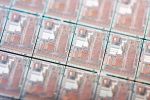EPJ D Highlight - Sharpening the focus in quantum photolithography
- Details
- Published on 11 December 2013

A new protocol, exploiting the quantum properties of materials, makes it possible to improve the accuracy of photolithography by addressing its physical limitations due to diffraction
Photolithography uses light beams to design thin geometric patterns on the substrates of semiconductors used in microelectronic devices. This is achieved using a chemical reaction on a light-sensitive chemical, called photoresist. The trouble is that the phenomenon of light diffraction does not permit highly accurate patterns. Often, the edges of stripes have low contrast, the distances between the stripes and the stripes’ width are limited by what is referred to as Rayleigh’s diffraction limit. Now, a scientist from Russia has developed a quantum lithography protocol designed to improve the resolution of this technology. The findings of George Miroshnichenko, a physicist at Saint-Petersburg National Research University of Information Technologies, Mechanics and Optics, in Russia, have just been published in EPJ D.
Until now, quantum lithograph protocols have been based on multi-photon absorption. This means that the frequency of the incoming light needed to be several times smaller than the frequency required for the absorption of a single photon, to trigger the absorption of multiple photons by the photoresist. As a result, this approach requires a higher wavelength, and produces lower resolution.
Instead, Miroshnichenko establishes the formula for the probability of a single—and no longer multiple—photon transition from a bound state of a quantum system to a state of continuous spectrum, using the so-called Markov approximation. This makes it possible to select the exposure time and the beam’s intensity to obtain a narrow stripe in the photoresist on the substrate.
Thus, in negative photoresist, this protocol can be used to create a stripe with a width equal to half the wavelength and high-contrast edges. For positive photoresist, thin stripes can be formed on the substrate with a width that is substantially smaller than the wavelength, but the distance between these stripes is equal to half the wavelength.
Quantum lithography on bound-free transitions, G. P. Miroshnichenko (2013), European Physical Journal D, DOI 10.1140/epjd/e2013-40586-2




